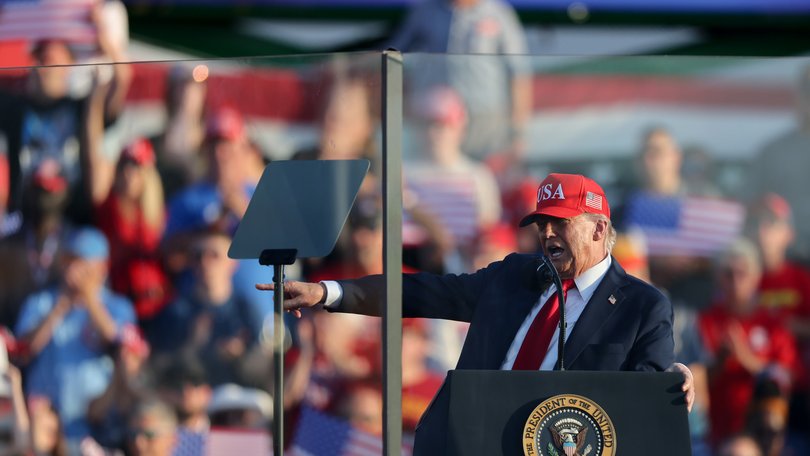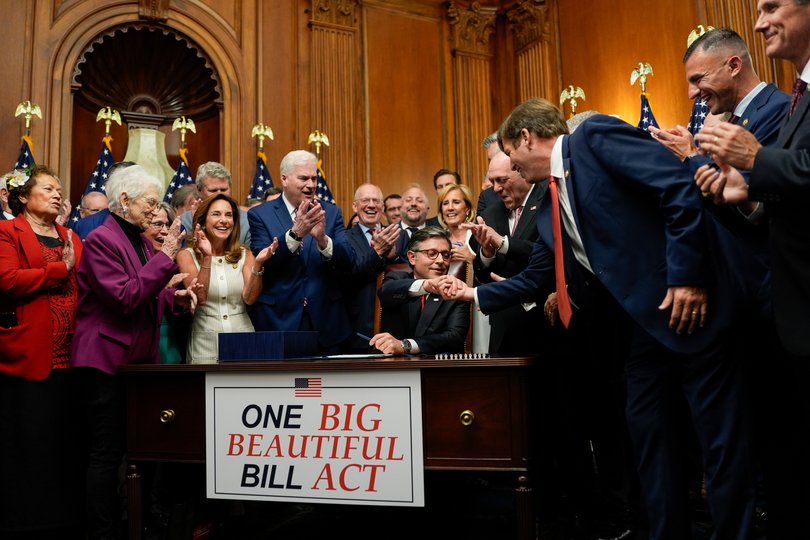JACKSON HEWETT: ‘Beautiful’ or broken? Trump’s bill adds trillions to US debt and will cost rest of the world

Alexander Hamilton would be turning in his grave.
The founding father may have been the progenitor of a national US debt, but even he would have been stunned by the extent to which spending and revenue have become uncoupled following the passage of the One Big Beautiful Bill on Independence Day.
The 900-plus page Act extends the tax cuts from Trump’s first term, at a cost of $US4.5 trillion ($AU6.8t) in foregone revenue.
Sign up to The Nightly's newsletters.
Get the first look at the digital newspaper, curated daily stories and breaking headlines delivered to your inbox.
By continuing you agree to our Terms and Privacy Policy.It is expected to add $3.5t in deficits over the next decade.
But the long-term impact is even greater, and still being calculated.
There is no realistic way to offset those revenue losses through spending cuts, though the administration has tried, primarily by slashing payments like Medicaid and food stamps to the poorest citizens. Undocumented immigrants, who form the backbone of many low-skilled labour industries, are particularly vulnerable.
In the short term, the tax cuts may deliver a sugar hit to the US economy.
The spending cuts are pushed into the future, while the tax relief arrives quickly, including expanded child tax credits and deductions for the elderly and on tips. Car buyers can deduct up to $10,000 a year in interest payments on American-made vehicles.
Businesses also benefit, with an increase in the small business threshold and expanded credits for investment in new machinery.
Trump’s pet industries receive generous support, while his bugbears are bashed.
Fossil fuel producers gain access to more Federal land for drilling and receive tax breaks, while clean energy funding is gutted. Tax breaks for electric vehicles are eliminated.
Rocket man Elon Musk may have lost out on EV subsidies, but space remains in favour, with another $10 billion allocated to moon and Mars exploration. Defence contractors also benefit, with $150b in spending as Trump eyes his Golden Dome project.
Ordinarily, such a massive tax handout would be expected to stimulate the US economy.
The top 10 per cent of earners will be better off by around $13,500 a year, while households enjoy expanded offsets for State taxes and higher child tax credits

US stock markets, closed for the July 4 weekend, are already near record highs and set to receive “lots of pork,” according to Christian Baylis, founder of Fortlake Asset Management.
“Equity markets love this bill. It is more accelerant,” he said.
Republicans are promising that US growth will take off as a result.
But that promise collides with Donald Trump’s other signature policy: tariffs.
We will not know how much Trump plans to clip from imports until next week, but estimates suggest tariffs will average around 13 per cent.
Unless importers can absorb those margins indefinitely, that 13 per cent will be passed on to prices. According to the Peterson Institute for International Economics, the tariff impost is effectively a tax on consumers that outweighs the tax cuts for 80 per cent of US households.
It also clashes with the harsh reality the bill presents for poorer Americans.
The bill strips $1.1t from Medicaid, Medicare and Obamacare, leaving 11.8 million more Americans uninsured by 2023. That makes them either reliant on unaffordable private insurance or facing crushing medical bills. Either way, it drains money from consumers’ wallets.
Businesses will also feel the impact. Up to 20m mostly low-wage American workers in industries like retail, services, health care, manufacturing, transport, education and agriculture get health care through Medicaid, while one in five small businesses rely on it.
At the same time, Donald Trump has been calling for Jerome Powell to slash interest rates to 1.25 per cent from the current 4.25 per cent, yet the bill puts upward pressure on inflation and, by extension, interest rates.
The US economy is already running hot enough for Mr Powell to resist a cut, and he has been waiting for a more definitive read on what tariffs will do to prices.
With this massive stimulus bill now passed, the Fed will want a clearer picture of how tax cuts flow through to spending demand.
But it is in the longer term that things really start to get messy.
According to the Yale Budget Lab, the bill will add $US12.1t to the debt by 2055, assuming the temporary tax cuts are allowed to expire. But if, as history suggests, Congress extends them, the cost rises to $US16.1t over 30 years.
If the tax provisions become permanent, US debt will be nearly double the size of its GDP. Only Japan and Sudan currently carry higher levels of government debt.
Interest payments on government debt, already greater than what the US spends on defence, will increase by $US917b by 2034. By mid-century, the weight of interest alone becomes staggering, accounting for nearly 90 per cent of the bill’s total fiscal burden, according to Yale Budget Lab.
That assumes no further rise in interest rates due to higher deficits. If debt-servicing costs increase, as they likely will, the ratio worsens.
Ballooning deficits in the US will have a flow-on effect across the rest of the world.
As the US issues more and more bonds to pay for the spending, it will absorb increasing amounts of global capital.
That puts upward pressure on interest rates worldwide, either because capital becomes scarcer or because the US must offer increasingly attractive yields to lure investors.
US government bonds are the benchmark for global interest rates. If those yields surge, we will feel it in our own borrowing costs—mortgages, credit cards and car loans.
American exceptionalism is driving Trump’s agenda, but it comes with a shared burden. For 70 years, the US has benefited from its position as the dominant economic power. The US dollar’s role as the global reserve currency has allowed it to enjoy unnaturally low interest rates.
But the greater the debt, the higher the chance of default. Trump’s term will likely end before that risk becomes real, but a fiscally unsound America is another brick removed from the Jenga tower of the global financial system.
This bill, combined with Trump’s tariff agenda, is not just pulling the US in different directions. It is also distorting the policy frameworks of governments around the world.
Every central banker will now be thinking more about survival than stability. That makes the prosperity-building consensus of the past 50 years look increasingly fragile.

